Effects of Organic and Inorganic Fertilizers on Soil Nutrient Conditions in Rice Fields with Varying Soil Fertility
Abstract
:1. Introduction
2. Materials and Methods
2.1. Test Materials and Sites
2.2. Experimental Design
2.3. Soil Property Measurements
2.4. Combined Soil Fertility Values
2.5. Soil Enzyme Activity Composite Index
2.6. Statistical Analysis
3. Results
3.1. Effects of Fertilizer Treatments on Rice Soil Physical Properties
3.2. Effects of Fertilizer Treatments on Rice Soil Nutrients
3.3. Effects of Fertilizer Treatment on Combined Soil Fertility Values
3.4. Effects of Fertilizer Treatment on Enzyme Activity in Rice Soil
3.4.1. Urease
3.4.2. Acid Phosphatase
3.4.3. Sucrase
3.4.4. Combined Soil Enzyme Activity Index
3.4.5. Analysis of Simple Interactions between Location and Treatment with Indicators
Analysis of Simple Interactions between Location and Metrics
Analysis of Simple Interactions between Treatments and Metrics
4. Discussion
5. Conclusions
Author Contributions
Funding
Data Availability Statement
Conflicts of Interest
References
- Zhou, J. An overview of soil quality changes and sustainable use of arable land resources in China. Proc. Chin. Acad. Sci. 2015, 30, 459–467. [Google Scholar]
- Shen, R.; Wang, C.; Sun, B. Soil science and technology in the implementation of the strategy of “hiding grain in the land and hiding grain in technology”. Proc. Chin. Acad. Sci. 2018, 33, 135–144. [Google Scholar] [CrossRef]
- Lu, Y.; Liao, Y.; Nie, J.; Zhou, X.; Xie, J.; Yang, Z. Effect of continuous fertilizer application on changes in base ground strength and soil nutrients in paddy soils with different fertility. Chin. Agric. Sci. 2016, 49, 4169–4178. [Google Scholar]
- Zhang, S.; Nie, L. Application of arable land strength evaluation results to guide scientific fertilization of rice. Mod. Agric. 2018, 462, 18–21. [Google Scholar]
- Zheng, S.; Liao, Y.; Yang, Z.; Xie, J.; Nie, J.; Wu, X.; Xiang, Y. Fertility characteristics of rice soils with different productivity in double-season rice growing areas in Hunan. J. Plant Nutr. Fertil. 2011, 17, 1108–1121. [Google Scholar]
- Pang, D.; Chen, J.; Tang, Y.; Yin, Y.; Yang, D.; Cui, Z.; Zheng, M.; Li, Y.; Wang, Z. Effects of maize straw return method and nitrogen fertilizer treatment on soil physicochemical properties and winter wheat yield. J. Crop Sci. 2016, 42, 1689–1699. [Google Scholar]
- Wang, Y.; Li, H.; Han, Y.; Zhang, H.; Tan, J. Study on soil fertility differences between ultra-high yielding and high yielding fields in tidal soils. N. China J. Agric. 2012, 27, 197–201. [Google Scholar]
- Guo, L.; Zheng, C.; Cao, C.; Dang, H.; Ma, J.; Li, K. Effects of soil fertility and fertilization measures on the ground power contribution and soil capacity of winter wheat-summer corn yield. Hebei Agric. Sci. 2016, 20, 29–33. [Google Scholar]
- Le Bissonnais, Y. Aggregate stability and assessment of soil crustability and erodibility: I. Theory and methodology. Eur. J. Soil Sci. 2016, 67, 11–21. [Google Scholar] [CrossRef]
- Yang, X.-M.; Wander, M.M. Temporal changes in dry aggregate size and stability: Tillage and crop effects on a silty loam Mollisol in Illinois. Soil Tillage Res. 1998, 49, 173–183. [Google Scholar] [CrossRef]
- Jiang, C.; He, Y.; Liu, X.; Chen, P.; Wang, Y.; Li, H. Effects of long-term organic fertilizer application on the structure and stability of dryland red soil agglomerates. J. Soil Sci. 2010, 47, 715–722. [Google Scholar]
- Liang, Y.; Yuan, Y.; Han, X.; Li, L.; Zou, W.; Ren, J.; Li, G. Effect of chemical fertilizers with different doses of organic fertilizers on the distribution of organic carbon and humic acid in black soil agglomerates. J. Plant Nutr. Fertil. 2016, 22, 9. [Google Scholar]
- Xu, S.; Wang, Y.; Wang, H.; Zhu, F.; Ran, Y.; Chen, J. Stability of soil aggregates at different fertility levels and their response to nitrogen fertilizer salt solutions. J. Plant Nutr. Fertil. 2012, 18, 1135–1143. [Google Scholar]
- Liang, T.; Liao, D.; Chen, X.; Wang, S.; Fu, D.; Chen, X.; Shi, X. Effect of basal ground level on nutrient use efficiency of rice fields in Chongqing. Chin. Agric. Sci. 2018, 51, 3106–3116. [Google Scholar]
- Liang, B.; Yang, X.; Murphy, D.V.; He, X.; Zhou, J. Fate of 15 N-labeled fertilizer in soils under dryland agriculture after 19 years of different fertilizations. Biol. Fertil. Soils 2013, 49, 977–986. [Google Scholar] [CrossRef]
- Li, R. Influence of Different Base Landraces on Rce Yield and Fertilizer Use Efficiency. Master’s Thesis, Huazhong Agricultural University, Wuhan, China, 2011. [Google Scholar]
- Li, M.; Zhang, X. Soil fertility evaluation of different soil configurations and analysis of the relationship between soil fertility and capacitance. Soil Bull. 2011, 42, 1420–1427. [Google Scholar] [CrossRef]
- Álvaro-Fuentes, J.; Morell, F.J.; Madejón, E.; Lampurlanés, J.; Arrúe, J.L.; Cantero-Martínez, C. Soil biochemical properties in a semiarid Mediterranean agroecosystem as affected by long-term tillage and N fertilization. Soil Tillage Res. 2013, 129, 69–74. [Google Scholar] [CrossRef]
- Xue, J.; Gao, Y.; Wang, J.; Fu, S.; Zhu, F. Exploration of soil microbial carbon and nitrogen as soil fertility indicators. Soil Bull. 2007, 2, 247–250. [Google Scholar] [CrossRef]
- García-Ruiz, R.; Ochoa, V.; Hinojosa, M.B.; Carreira, J.A. Suitability of enzyme activities for the monitoring of soil quality improvement in organic agricultural systems. Soil Biol. Biochem. 2008, 40, 2137–2145. [Google Scholar] [CrossRef]
- Wang, N.; Wang, S.; Gao, Q.; Zhao, L.; Tian, T.; Zhang, J. Effect of nitrogen application level on microbiological properties of soils with different fertility. J. Soil Water Conserv. 2014, 28, 148–152+167. [Google Scholar] [CrossRef]
- Qiu, L.; Liu, J.; Wang, Y.; Sun, H.; He, W. Study on the relationship between soil enzyme activity and soil fertility. J. Plant Nutr. Fertil. 2004, 18, 277–280. [Google Scholar]
- Song, Y.; Lv, X.; Chen, W. Response of soil alkaline nitrogen and urease activity to different nitrogen levels in rice. North Rice 2010, 40, 8–12. [Google Scholar] [CrossRef]
- Ye, X.; Yang, C.; Li, Z.; Jing, H. Effect of green manure on soil enzyme activity and soil fertility of tobacco planting. J. Plant Nutr. Fertil. 2013, 19, 445–454. [Google Scholar]
- Hu, C.C.; Cao, C.P.; Ye, Z.N.; Wu, W.L. Effect of different soil fertilization measures on microbial biomass carbon in low fertility farmland. J. Ecol. 2006, 03, 808–814. [Google Scholar]
- Liu, Z.; Rong, Q.; Zhou, W.; Liang, G. Effects of inorganic and organic amendment on soil chemical properties, enzyme activities, microbial community and soil quality in yellow clayey soil. PLoS ONE 2017, 12, e0172767. [Google Scholar] [CrossRef]
- Yan, H.; Yu, Z.; Wang, X.; Li, C.; Zhao, L.; Ji, M.; Wang, L. Dynamic characteristics of soil microorganisms, enzymes and fast-acting nutrients under rototill-based maize straw return conditions. J. Soil Water Conserv. 2018, 32, 276–282. [Google Scholar] [CrossRef]
- Yuan, J.-K.; Zhou, Y. Accurate determination of soil bulk and porosity by improved ring knife method using soil extraction auger. Chin. Hortic. Abstr. 2014, 30, 2. [Google Scholar]
- Bao, S. Soil Agrochemical Analysis, 3rd ed.; China Agricultural Press: Beijing, China, 2000. [Google Scholar]
- Guan, S.-Y. Soil Enzymes and Their Research Methods; Agricultural Press: Beijing, China, 1986. [Google Scholar]
- Lv, Y. Soil Science; China Agricultural Press: Beijing, China, 2006. [Google Scholar]
- Liu, X.; Lu, R.; Dai, P.-B.; Ni, Z.; Chen, D. Effects of long-term fertilizer and organic fertilizer application on rice yield and soil fertility. Zhejiang Agric. Sci. 2018, 59, 694–697. [Google Scholar] [CrossRef]
- Liu, Y.; Li, Y.; Zhang, Y.; Zhang, W.; Huang, X.; Jiang, T. Effect of long-term different fertilization treatments on physicochemical properties of loamy rice soils. Jiangsu Agric. Sci. 2017, 45, 5. [Google Scholar]
- Richter, J.; Roelcke, M. The N-cycle as determined by intensive agriculture–examples from central Europe and China. Nutr. Cycl. Agroecosyst. 2000, 57, 33–46. [Google Scholar] [CrossRef]
- Bernal, M.; Sanchez-Monedero, M.; Paredes, C.; Roig, A. Carbon mineralization from organic wastes at different composting stages during their incubation with soil. Agric. Ecosyst. Environ. 1998, 69, 175–189. [Google Scholar] [CrossRef]
- Preusch, P.; Adler, P.; Sikora, L.; Tworkoski, T. Nitrogen and phosphorus availability in composted and uncomposted poultry litter. J. Environ. Qual. 2002, 31, 2051–2057. [Google Scholar] [CrossRef]
- Yang, J.W.; Tang, G.M.; Li, R.Z.; Yuan, X.; Yuan, H.; Jiang, S. Simulation study on soil-surface water nitrogen and phosphorus migration characteristics in flooded agricultural fields. J. Irrig. Drain. 2018, 037, 71–77. [Google Scholar]
- Wang, B.; Li, J.; Ren, Y.; Xin, J.; Hao, X.; Ma, Y.; Ma, X. Validation of a soil phosphorus accumulation model in the wheat–maize rotation production areas of China. Field Crops Res. 2015, 178, 42–48. [Google Scholar] [CrossRef]
- Reddy, D.D.; Rao, A.S.; Rupa, T. Effects of continuous use of cattle manure and fertilizer phosphorus on crop yields and soil organic phosphorus in a Vertisol. Bioresour. Technol. 2000, 75, 113–118. [Google Scholar] [CrossRef]
- Wang, S.; Liang, X.; Chen, Y.; Luo, Q.; Liang, W.; Li, S.; Huang, C.; Li, Z.; Wan, L.; Li, W. Phosphorus loss potential and phosphatase activity under phosphorus fertilization in long-term paddy wetland agroecosystems. Soil Sci. Soc. Am. J. 2012, 76, 161–167. [Google Scholar] [CrossRef]
- Zhao, J.; Ni, T.; Li, J.; Lu, Q.; Fang, Z.; Huang, Q.; Zhang, R.; Li, R.; Shen, B.; Shen, Q. Effects of organic–inorganic compound fertilizer with reduced chemical fertilizer application on crop yields, soil biological activity and bacterial community structure in a rice–wheat cropping system. Appl. Soil Ecol. 2016, 99, 1–12. [Google Scholar] [CrossRef]
- Allison, V.; Condron, L.; Peltzer, D.; Richardson, S.; Turner, B. Changes in enzyme activities and soil microbial community composition along carbon and nutrient gradients at the Franz Josef chronosequence, New Zealand. Soil Biol. Biochem. 2007, 39, 1770–1781. [Google Scholar] [CrossRef]
- Vepsäläinen, M.; Kukkonen, S.; Vestberg, M.; Sirviö, H.; Niemi, R.M. Application of soil enzyme activity test kit in a field experiment. Soil Biol. Biochem. 2001, 33, 1665–1672. [Google Scholar] [CrossRef]
- Deng, X.; Chen, M.; Wu, C.; Li, Q. Effect of different fertilization patterns on soil enzyme activity in pepper-winter melon crop rotation. Jiangsu Agric. Sci. 2018, 46, 4. [Google Scholar]
- Lee, J. Effect of application methods of organic fertilizer on growth, soil chemical properties and microbial densities in organic bulb onion production. Sci. Hortic. 2010, 124, 299–305. [Google Scholar] [CrossRef]
- Liu, E.; Yan, C.; Mei, X.; He, W.; Bing, S.H.; Ding, L.; Liu, Q.; Liu, S.; Fan, T. Long-term effect of chemical fertilizer, straw, and manure on soil chemical and biological properties in northwest China. Geoderma 2010, 158, 173–180. [Google Scholar] [CrossRef]
- Li, J.; Xin, X.; Li, J.; Yu, X.; Wu, J.; Han, Y. Effect of long-term locational fertilization on soil enzyme activity under maize-soybean crop rotation. J. Shenyang Agric. Univ. 2015, 46, 7. [Google Scholar]
- Song, Y.; Yu, J.; Chen, S.; Xiao, C.; Li, Y.; Su, X.; Ding, F. Effect of chemical fertilizer reduction with bio-organic fertilizer on the growth and soil microbial and enzyme activities of oilseed rape. J. Soil Water Conserv. 2018, 32, 9. [Google Scholar]
- Wan, Z.; Song, C. Characteristics of enzyme activity distribution in Little Leaf Chapter wetland and its relationship with active organic carbon characterization index. Wetl. Sci. 2008, 26, 2282–2290. [Google Scholar]

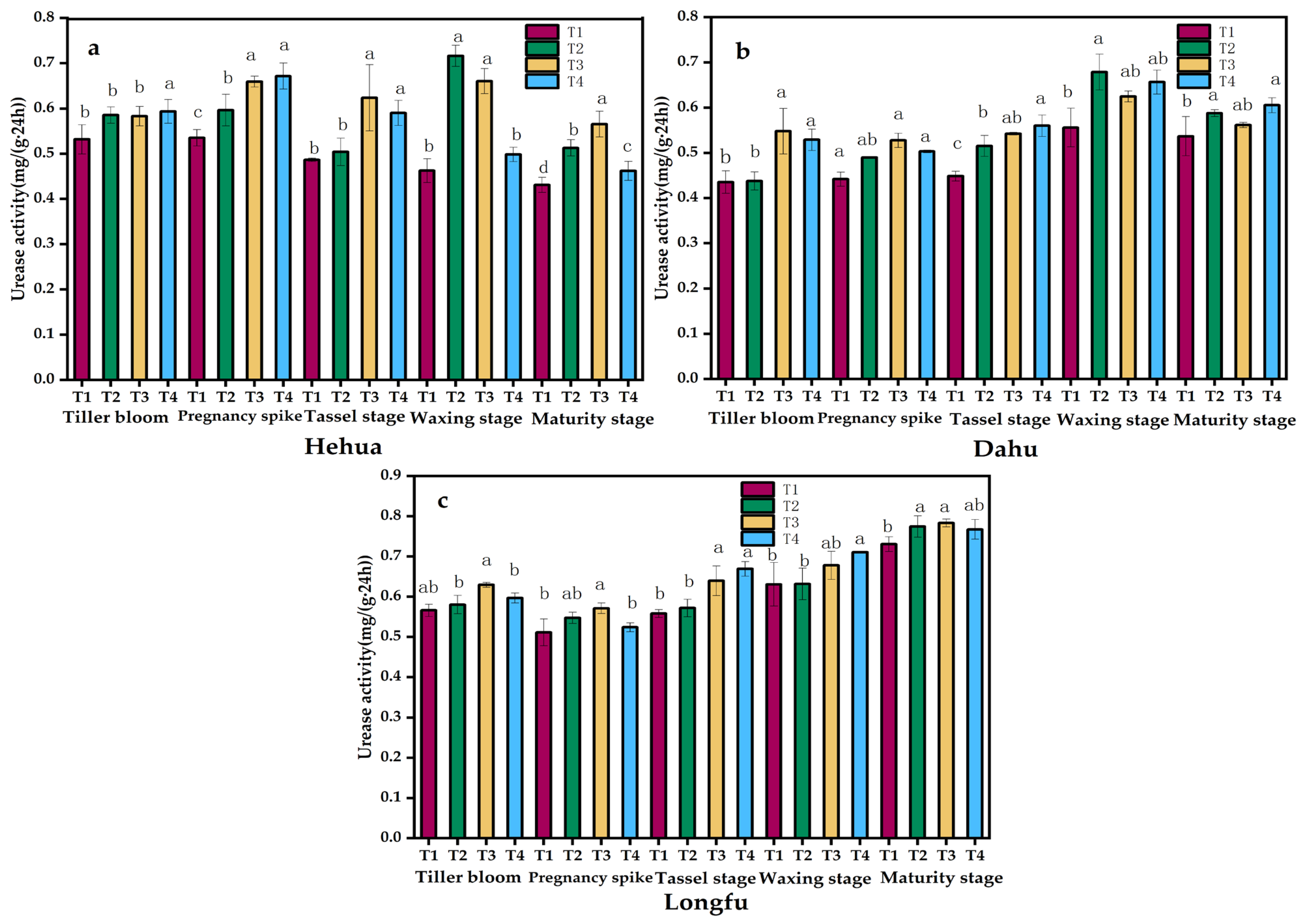
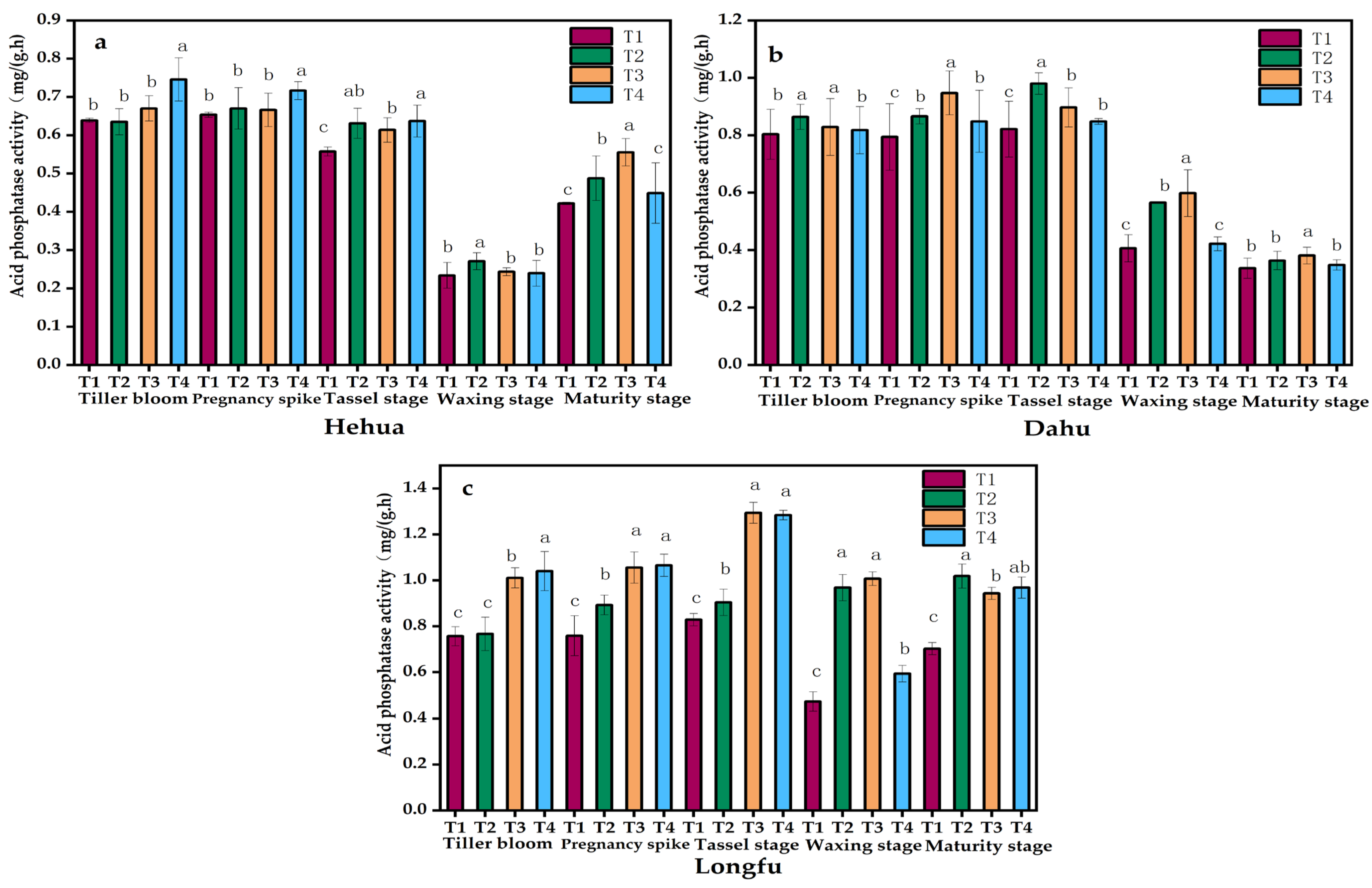
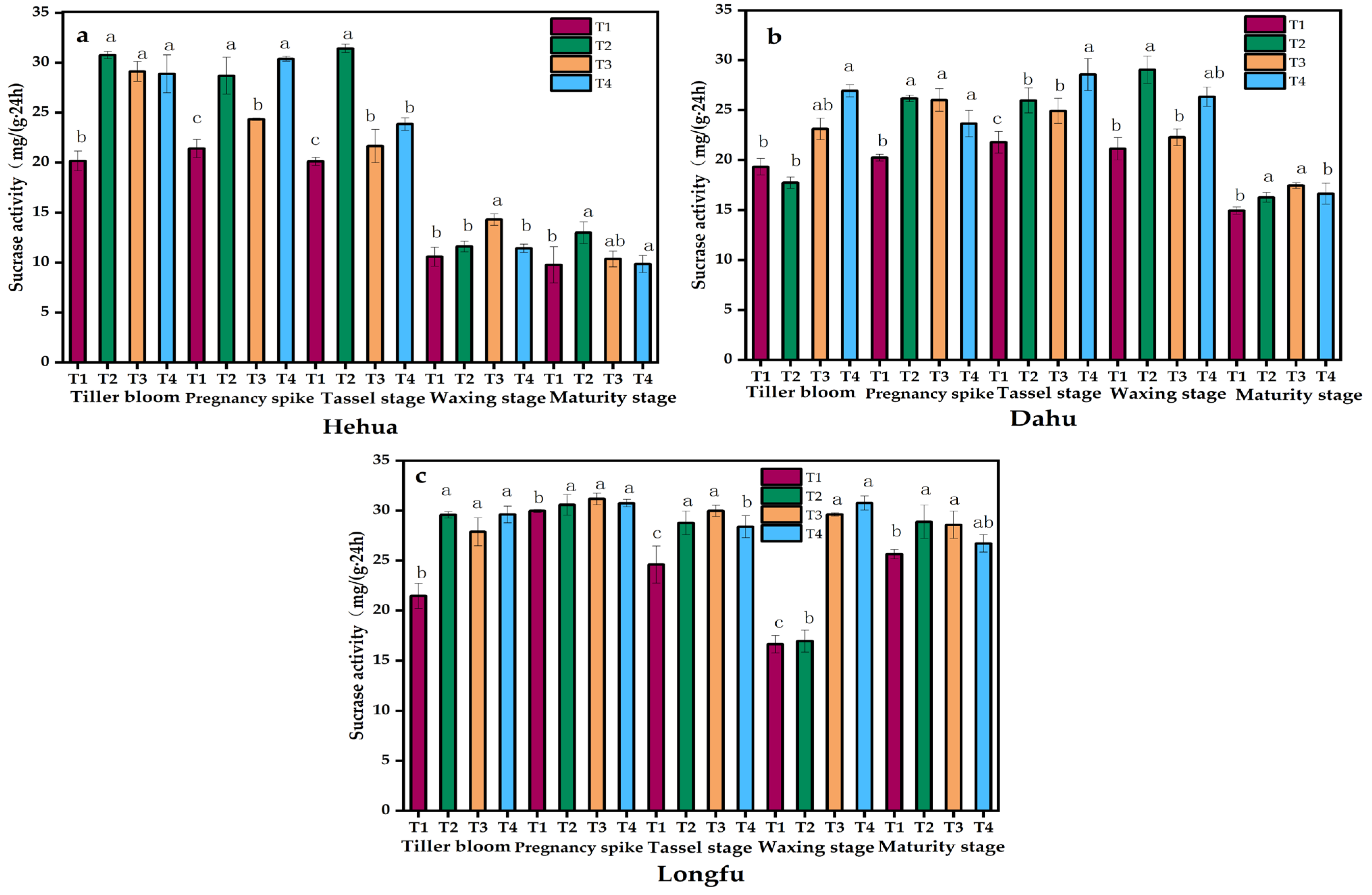
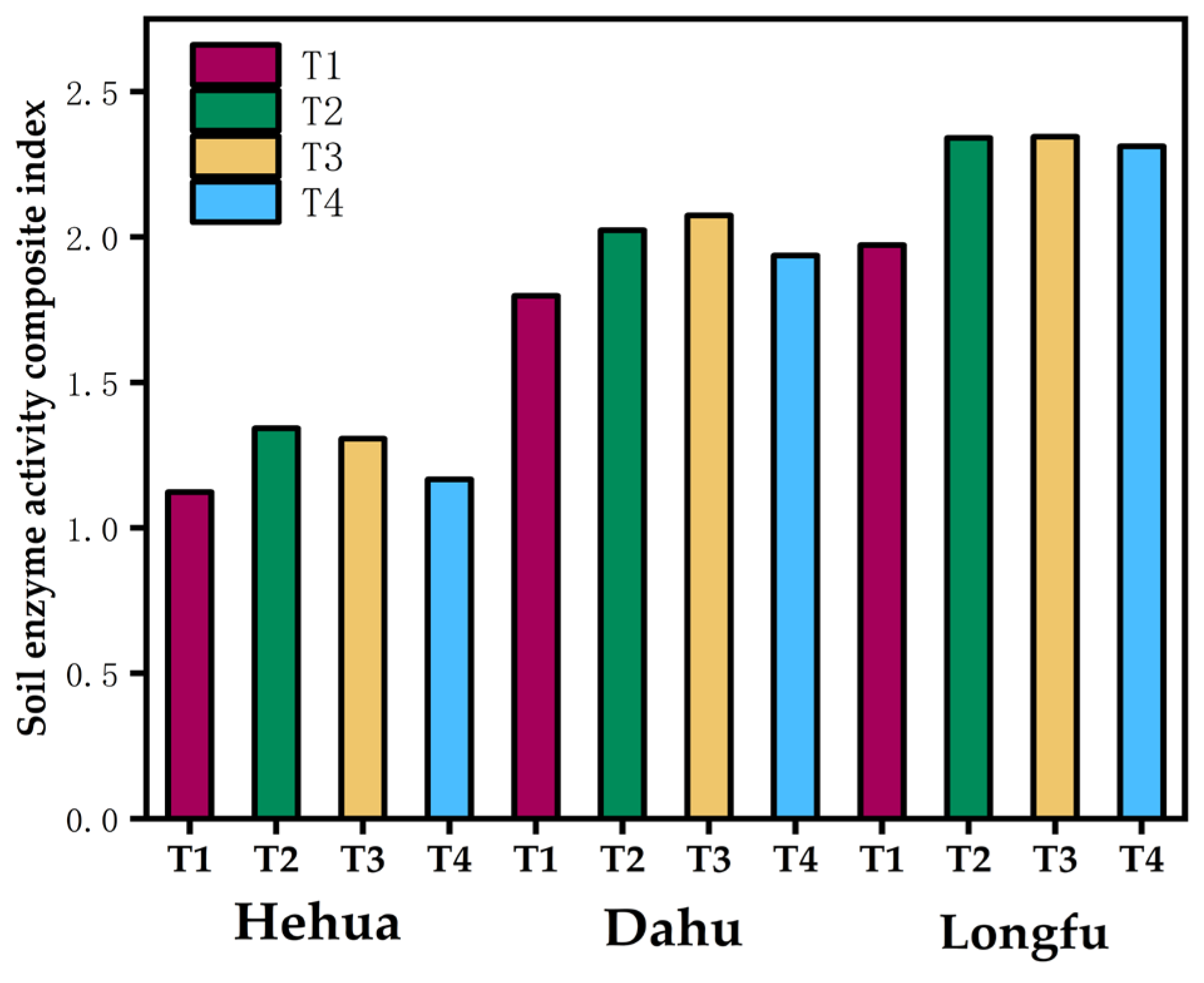
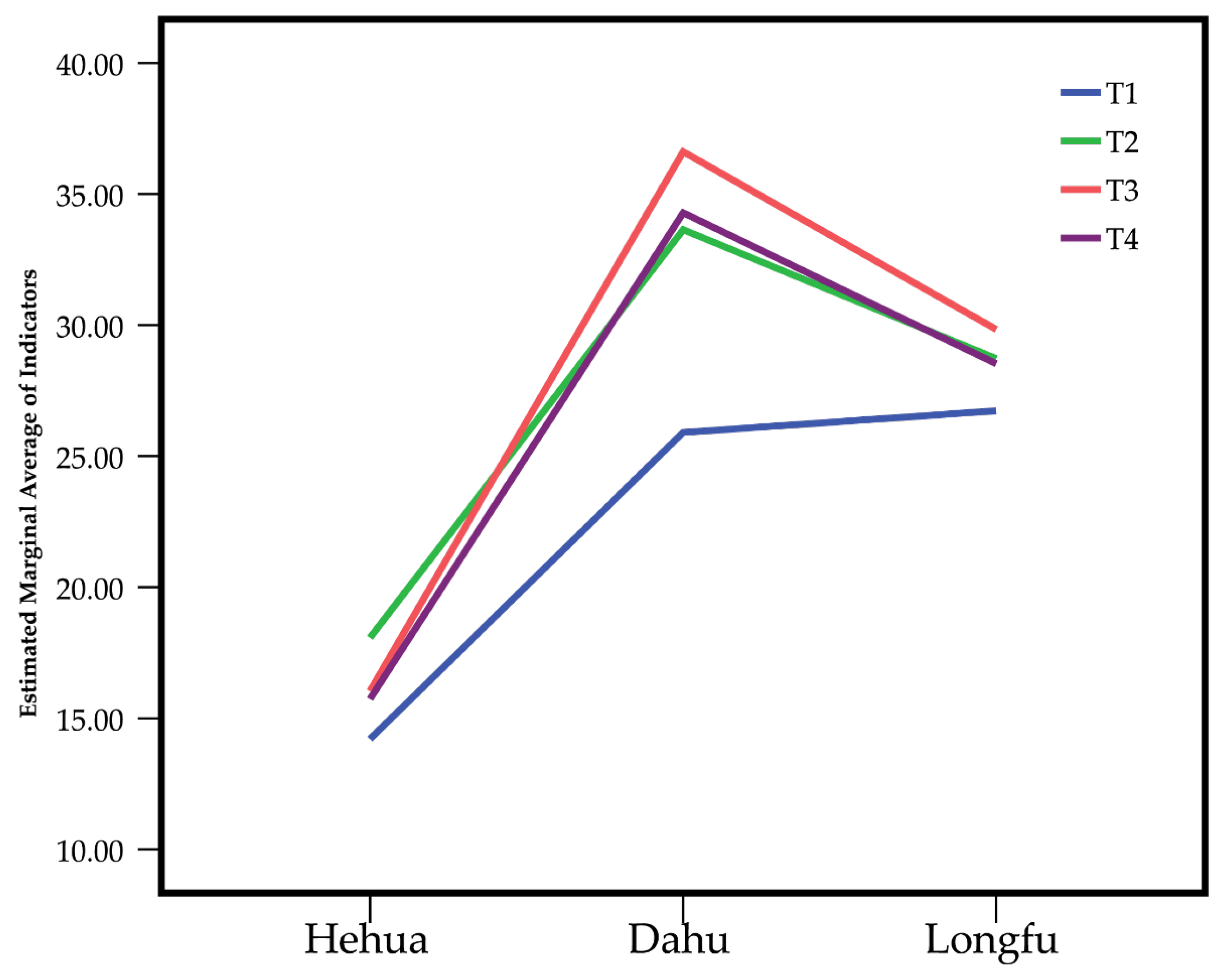


| Treatment Group Name | Treatment Group Description | Inorganic Fertilizer | Organic Fertilizer | Total | ||||||
|---|---|---|---|---|---|---|---|---|---|---|
| N | P2O5 | K2O | Pig Manure | Zoysia | Rice Straw | N | P2O5 | K2O | ||
| T1 | No fertilizer | - | - | - | - | - | - | - | - | - |
| T2 | Standard fertilizer | 171.0 | 69.0 | 113.4 | 1500 | - | - | 180 | 75 | 120 |
| T3 | 40% organic fertilizer | 108.0 | 51.6 | 42.6 | - | 12,600 | 3600 | 180 | 75 | 120 |
| T4 | 100% chemical fertilizer | 180.0 | 75.0 | 120.0 | - | - | - | 180 | 75 | 120 |
| Sample Site | pH | Organic Matter (g/kg) | Total Nitrogen (g/kg) | Total Phosphorus (g/kg) | Total Potassium (g/kg) | Available Nitrogen (mg/kg) | Available Phosphorus (mg/kg) | Available Potassium (mg/kg) |
|---|---|---|---|---|---|---|---|---|
| Hehua | 6.45 | 11.55 | 0.75 | 0.60 | 13.55 | 84.82 | 4.12 | 68.21 |
| Dahu | 5.65 | 25.45 | 1.35 | 0.84 | 8.03 | 155.38 | 3.63 | 72.34 |
| Longfu | 5.92 | 28.21 | 1.82 | 0.35 | 8.60 | 150.04 | 12.85 | 60.31 |
| Grade | Organic Matter (g/kg) | Nitrogen Alkali Digestion (mg/kg) | Fast-Acting Potassium (mg/kg) | Effective Phosphorus (mg/kg) |
|---|---|---|---|---|
| Xa | 10 | 60 | 40 | 3 |
| Xc | 20 | 120 | 100 | 10 |
| XP | 30 | 180 | 150 | 20 |
| Treatment Group | Soil Capacity (g/cm3) | Soil Porosity (%) | ||||
|---|---|---|---|---|---|---|
| Hehua | Dahu | Longfu | Hehua | Dahu | Longfu | |
| T1 | 0.99 ± 0.090 a | 0.79 ± 0.075 a | 1.19 ± 0.069 a | 62.56 ± 0.090 a | 58.83 ± 0.075 a | 58.84 ± 0.069 a |
| T2 | 1.02 ± 0.044 a | 1.09 ± 0.121 a | 1.09 ± 0.045 a | 61.55 ± 0.044 a | 57.95 ± 0.121 a | 60.25 ± 0.045 a |
| T3 | 1.05 ± 0.080 a | 1.11 ± 0.069 a | 1.05 ± 0.053 a | 60.50 ± 0.080 a | 57.14 ± 0.069 a | 59.64 ± 0.053 a |
| T4 | 0.93 ± 0.065 a | 1.14 ± 0.088 a | 1.07 ± 0.066 a | 64.74 ± 0.065 a | 54.94 ± 0.088 a | 57.39 ± 0.066 a |
| Sample Site | Treatment Group | Total Nitrogen (g/kg) | Total Phosphorus (g/kg) | Organic Matter (g/kg) |
|---|---|---|---|---|
| Hehua | T1 | 0.76 ± 0.085 a | 0.68 ± 0.005 c | 11.85 ± 1.075 a |
| T2 | 0.79 ± 0.034 a | 0.79 ± 0.020 b | 12.35 ± 1.553 a | |
| T3 | 0.77 ± 0.046 a | 0.89 ± 0.050 a | 12.62 ± 2.775 a | |
| T4 | 0.87 ± 0.040 a | 0.75 ± 0.015 b | 14.11 ± 2.259 a | |
| Dahu | T1 | 1.00 ± 0.097 b | 0.92 ± 0.005 c | 24.90 ± 3.030 b |
| T2 | 1.36 ± 0.119 a | 0.95 ± 0.011 b | 27.03 ± 1.235 ab | |
| T3 | 1.37 ± 0.149 a | 0.98 ± 0.016 a | 28.96 ± 0.325 a | |
| T4 | 1.36 ± 0.048 a | 0.94 ± 0.007 b | 26.21 ± 0.729 ab | |
| Longfu | T1 | 1.82 ± 0.048 a | 0.42 ± 0.005 d | 28.47 ± 0.620 a |
| T2 | 2.02 ± 0.188 a | 0.58 ± 0.002 a | 30.63 ± 1.156 a | |
| T3 | 1.83 ± 0.511 a | 0.52 ± 0.005 b | 30.53 ± 1.590 a | |
| T4 | 1.83 ± 0.118 a | 0.46 ± 0.005 c | 30.37 ± 4.468 a |
| Sample Site | Nutrient Indicator (mg/kg) | Treatment group | Tiller Bloom | Pregnancy Spike | Tassel | Waxing | Maturity |
|---|---|---|---|---|---|---|---|
| Hehua | Alkaline nitrogen content | T1 | 94.03 ± 0.404 c | 83.07 ± 0.808 c | 97.98 ± 3.453 b | 77.70 ± 0.926 b | 83.90 ± 3.245 b |
| T2 | 114.33 ± 1.070 b | 100.57 ± 8.697 a | 98.58 ± 4.041 b | 91.00 ± 8.231 a | 104.53 ± 4.351 a | ||
| T3 | 117.37 ± 0.404 a | 95.55 ± 1.750 ab | 106.87 ± 1.125 a | 86.30 ± 1.424 ab | 90.77 ± 1.762 ab | ||
| T4 | 116.43 ± 1.070 a | 90.53 ± 0.808 bc | 102.62 ± 2.671 ab | 82.48 ± 4.829 ab | 90.07 ± 5.300 ab | ||
| Effective phosphorus | T1 | 2.33 ± 0.858 d | 6.49 ± 3.250 b | 7.95 ± 1.032 c | 7.68 ± 2.575 d | 5.87 ± 2.730 c | |
| T2 | 4.97 ± 1.741 c | 9.47 ± 1.487 a | 12.17 ± 4.763 b | 12.04 ± 0.991 b | 12.18 ± 2.951 a | ||
| T3 | 7.97 ± 1.983 b | 9.73 ± 2.988 a | 14.09 ± 6.157 a | 13.86 ± 4.814 a | 11.81 ± 1.247 a | ||
| T4 | 8.52 ± 0.744 a | 9.10 ± 3.481 a | 15.25 ± 2.543 a | 10.42 ± 2.730 c | 9.37 ± 0.991 b | ||
| Dahu | Alkaline nitrogen content | T1 | 133.01 ± 7.000 c | 104.07 ± 8.640 c | 149.92 ± 14.534 c | 125.07 ± 4.554 c | 157.50 ± 2.425 c |
| T2 | 175.11 ± 7.000 b | 162.40 ± 1.852 b | 173.25 ± 3.654 b | 212.68 ± 4.057 a | 205.10 ± 0.700 b | ||
| T3 | 189.23 ± 0.001 b | 196.00 ± 3.051 a | 204.35 ± 13.376 a | 204.98 ± 3.909 a | 233.57 ± 8.015 a | ||
| T4 | 217.63 ± 13.301 a | 191.33 ± 2.650 a | 221.78 ± 2.627 a | 161.82 ± 1.654 b | 218.40 ± 4.850 ab | ||
| Effective phosphorus | T1 | 1.44 ± 2.623 c | 2.66 ± 1.593 d | 4.18 ± 1.741 d | 2.86 ± 2.064 d | 3.22 ± 0.496 d | |
| T2 | 3.39 ± 1.032 a | 11.71 ± 4.157 a | 9.66 ± 3.574 a | 12.01 ± 2.818 a | 13.56 ± 3.516 a | ||
| T3 | 4.21 ± 3.469 a | 9.50 ± 0.572 b | 7.52 ± 1.247 b | 7.45 ± 1.032 b | 8.08 ± 1.311 b | ||
| T4 | 2.33 ± 1.487 b | 5.70 ± 2.760 c | 4.64 ± 1.359 c | 4.11 ± 2.160 c | 5.63 ± 1.593 c | ||
| Longfu | Alkaline nitrogen content | T1 | 143.80 ± 2.211 c | 142.63 ± 1.779 b | 151.67 ± 9.812 b | 132.07 ± 5.658 a | 142.57 ± 6.274 b |
| T2 | 150.73 ± 3.523 b | 146.07 ± 10.200 b | 163.10 ± 2.145 ab | 143.97 ± 2.458 a | 150.97 ± 4.102 ab | ||
| T3 | 157.97 ± 5.064 a | 148.63 ± 0.809 ab | 187.017 ± 4.700 a | 145.83 ± 2.977 a | 155.40 ± 0.700 a | ||
| T4 | 146.17 ± 1.070 c | 157.03 ± 2.139 a | 151.73 ± 2.357 b | 148.17 ± 2.6501 a | 152.83 ± 6.870 a | ||
| Effective phosphorus | T1 | 10.39 ± 1.741 b | 20.11 ± 8.058 b | 19.08 ± 2.271 c | 18.29 ± 7.027 b | 17.36 ± 3.300 c | |
| T2 | 11.78 ± 4.965 b | 20.93 ± 0.572 b | 19.61 ± 4.989 bc | 18.78 ± 3.095 b | 18.78 ± 3.469 b | ||
| T3 | 14.32 ± 1.787 a | 25.33 ± 1.314 a | 22.16 ± 1.983 a | 17.36 ± 2.904 b | 21.66 ± 0.858 a | ||
| T4 | 11.32 ± 5.253 b | 20.64 ± 2.904 b | 20.24 ± 0.572 b | 21.85 ± 2.976 a | 18.42 ± 3.753 bc |
Disclaimer/Publisher’s Note: The statements, opinions and data contained in all publications are solely those of the individual author(s) and contributor(s) and not of MDPI and/or the editor(s). MDPI and/or the editor(s) disclaim responsibility for any injury to people or property resulting from any ideas, methods, instructions or products referred to in the content. |
© 2023 by the authors. Licensee MDPI, Basel, Switzerland. This article is an open access article distributed under the terms and conditions of the Creative Commons Attribution (CC BY) license (https://creativecommons.org/licenses/by/4.0/).
Share and Cite
Ma, G.; Cheng, S.; He, W.; Dong, Y.; Qi, S.; Tu, N.; Tao, W. Effects of Organic and Inorganic Fertilizers on Soil Nutrient Conditions in Rice Fields with Varying Soil Fertility. Land 2023, 12, 1026. https://doi.org/10.3390/land12051026
Ma G, Cheng S, He W, Dong Y, Qi S, Tu N, Tao W. Effects of Organic and Inorganic Fertilizers on Soil Nutrient Conditions in Rice Fields with Varying Soil Fertility. Land. 2023; 12(5):1026. https://doi.org/10.3390/land12051026
Chicago/Turabian StyleMa, Guozhu, Shenghai Cheng, Wenli He, Yixuan Dong, Shaowu Qi, Naimei Tu, and Weixu Tao. 2023. "Effects of Organic and Inorganic Fertilizers on Soil Nutrient Conditions in Rice Fields with Varying Soil Fertility" Land 12, no. 5: 1026. https://doi.org/10.3390/land12051026







